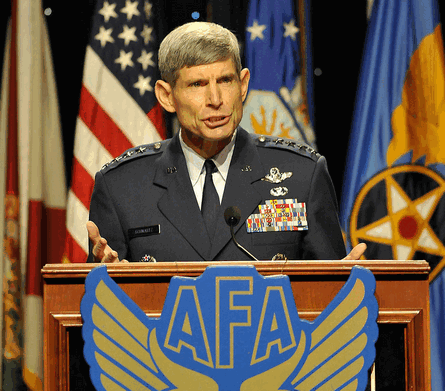Addressing a critical shortage of pilots to operate unmanned air systems has moved to the top of the modernisation priorities for the US Air Force's newly installed leadership.
General Norton Schwartz, appointed chief of staff in June, has unveiled a two-part plan to escalate the number of UAS operators from 300 to 1,100 in five years.
First, 100 pilots every year in undergraduate pilot training will be assigned to UAS operations. Second, the USAF will launch a distinct pipeline for UAS operators on a trial basis that will recruit from the ranks of active pilots and perhaps even retirees.
 |
|---|
"The air force culture must promote a strong and healthy UAS community - not a leper colony or an agency of expedience, and these initiatives are just a first step toward that end," said Schwartz, speaking to the Air Force Association's Air & Space 2008 convention on 16 September.
Only five months ago, Secretary of Defense Bob Gates compared his efforts to obtain the military's support for UAS operations to "pulling teeth". The USAF's top two leaders were fired two months later over lapses in nuclear safeguards.
But addressing UAS pilots shortages and overall intelligence, surveillance and reconnaissance (ISR) needs in Afghanistan and Iraq has already become a top priority for Schwartz. It was the only weapons modernisation initiative he launched during the high-profile AFA convention.
"We will do everything we can to ensure our UAS units are properly organised, trained and equipped for today's fight, and prepared for future challenges," says Schwartz, a former special operations airlift pilot.
The USAF has also unveiled the Project Liberty plan to buy 37 Hawker Beechcraft RC-12 King Airs, which are aimed at augmenting the UAS fleet with manned ISR platforms. Schwartz has also previously disclosed that a sophisticated new sensor is under development called the "wide area airborne surveillance" (WAAS) system.
More traditional ISR platforms, such as the Northrop Grumman E-8C Joint Surveillance Target Attack Radar System (JSTARS) may also benefit.
Next year, Northrop will start flight testing a 400mm (16in) telescope generating 1.4Gb of imagery data across seven spectral bands aboard the E-8C, says Dale Burton, vice-president of ISR and battle management and command and control.
Called the Senior Year electro optical reconnaissance system (SYERS), currently flown aboard the U-2, the sensor will allow the E-8C to aim a camera at one target while it continues to scan its radar at other targets.
Northrop's ultimate goal is to transition the 7m (24ft)-wide area sensor for the multi-platform radar technology insertion programme (MP-RTIP) on to the E-8C, replacing the existing APY-7. The company is already scouting for an available Boeing 707 to serve as a testbed aircraft.
Source: Flight International























